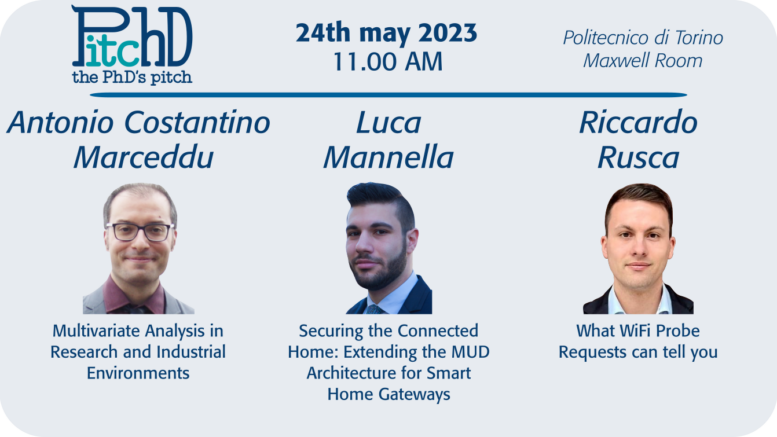24th May 2023 – 11.00 AM
Politecnico di Torino – Maxwell Room
Here’s the 2nd PitchD – the PhD’s pitch. Our PhD IEEE Student Members explain to students, colleagues and professors their research in-presence. Please, remember that registration is required to attend the event.
Multivariate Analysis in Research and Industrial Environments
Mr. Antonio Costantino Marceddu
Dept. of Automation and Control Engineering (DAUIN), Politecnico di Torino
Biography: Antonio Costantino Marceddu is a PhD student in Computer and Control Engineering at the Department of Control and Computer Engineering of the Politecnico di Torino. His work mainly focuses on the search for innovative solutions for visualizing in a human-readable way data coming from sensors using cutting-edge techniques and technologies, mainly belonging to Machine Learning, Extended Reality, and Computer Vision.
Abstract: Large amounts of data, such as that produced by sensors, especially cameras, can be used to reveal hidden links between the same data. To do this, visualization is often the most important tool. The main objective of the research is therefore to analyse, visualize and propose to the user data from different types of sensors.
Securing the Connected Home: Extending the MUD Architecture for Smart Home Gateways
Mr. Luca Mannella
Dept. of Automation and Control Engineering (DAUIN), Politecnico di Torino
Biography: Luca Mannella received his B.Sc. and M.Sc. in Computer Engineering from Politecnico di Torino. He also obtained the professional qualification for the profession of ICT engineer in September 2018. From September 2018 to October 2020, he was part of the IoT & Pervasive Technology research area of LINKS Foundation (former ISMB).
Since November 2020, he is enrolled in the Ph.D. in Computer and Control Engineering and a member of the e-Lite research group of Politecnico di Torino. He is also a teaching assistant for the Web Application I course at Politecnico di Torino. In his Ph.D., Luca is working on supporting developers in the cybersecurity of IoT systems, with a focus on smart home security.
Abstract: The integration of Internet of Things (IoT) systems into our homes, workplaces, and everyday lives has greatly expanded the surface area of cyber attacks. To mitigate the issue of having compromised devices involved in massive distributed attacks, the Internet Engineering Task Force (IETF) has introduced the Manufacturer Usage Description (MUD). This standard enables manufacturers to specify the allowed endpoints for their devices.
Considering that even developers play a critical role in ensuring the cybersecurity of IoT systems, this presentation will explore an extended version of the MUD architecture that focuses on smart home gateways extendible through plug-ins. This solution allows developers to specify the required endpoints for their plug-ins, resulting in a consolidated gateway-level MUD file. This ensures that even non-MUD-enabled devices, integrated through plug-ins, are protected by the MUD standard.
What WiFi Probe Requests can tell you
Mr. Riccardo Rusca
Dept. of Automation and Control Engineering (DAUIN), Politecnico di Torino
Biography: Riccardo Rusca got his Bachelor and Master Degree in Computer Engineering at Politecnico di Torino, in Italy. From November 2020 he is a PhD student in the same university under the supervision of Professor Claudio Ettore Casetti. His research is focused on crowd monitoring and city sensing techniques supported by next generation mobile networks. Furthermore, he is working on the 6G flagship Hexa-X project, focusing on Federated Learning for IoT devices in Smart Cities context to collaboratively learn optimal resource allocation given traffic demand.
Abstract: Everyday, as we go about our business in a city, we carry around several devices such as smartphones, tablets or even laptops, most of them with an active WiFi interface. This interface “leaks” wireless traces, or footprints, in the form of beacon or probe packets that can be used to identify the presence of people in certain areas. In particular, the analysis of device footprints allows the detection, tracking and monitoring of people in indoor and outdoor scenarios. In this paper, we focus on the probe request messages broadcast by wireless devices and we analyze the behaviour and the characteristics of these messages from different devices, coming from various vendors, with different operating systems and features, also considering the user interaction with them. In particular, we provide a detailed picture of the adoption of MAC address randomization techniques, and on the variety of fields present within the probe request messages.
Download the flyer:
![]()


